Sustainable Suburbia:
Exploring Village Homes in Davis, California!
All images are originals taken by me in Davis, except where noted.
What if I told you there’s a neighborhood that looks & functions just like your average suburbia...but sustainable?
Would you believe me? Personally, I was floored & thrilled when I found out that such a place can be fully imagined, let alone that it already exists - and has since the 80s!
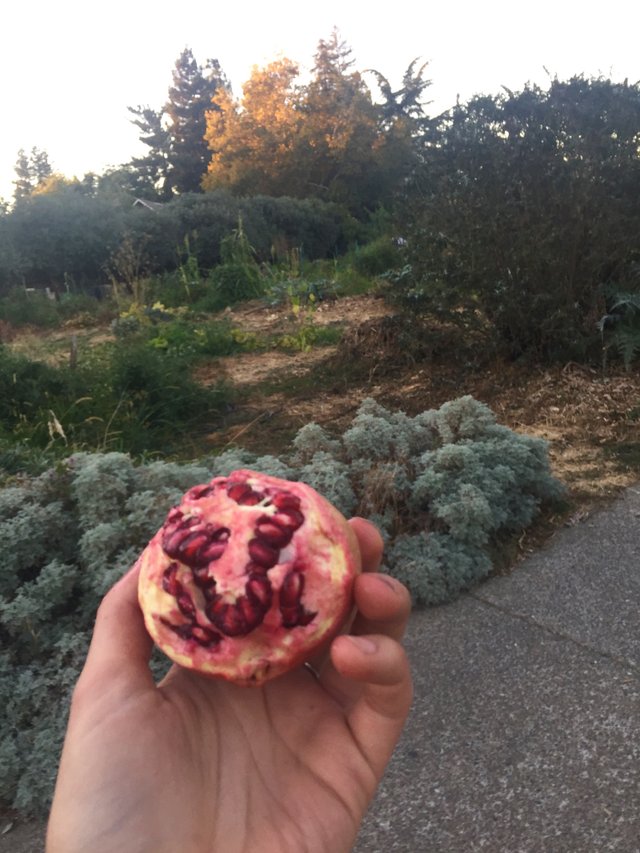
A pomegranate I picked up off the ground from the overflowing bushes at Village Homes.
No, it’s not a commune. No, not only hippies live there. Originally made famous (to me, anyway) via its inclusion in the photos section of Mollison’s Big Black Book - that’s the Permaculture Designer’s Manual for the uninitiated - depicting an idyllic, thoroughly green paradise that an idealist like me could happily thrive in, I've been craving a visit here for years. Village Homes in Davis, California
(near Sacramento) is a green developer’s dream: a model sustainable community that offers every modern amenity & an abundance of food practically dripping from every living surface. This 240 home, 70 acre suburban development has greenbelts, orchards, vineyards, garden areas, sports fields & even water features using nothing but solar power & the retention of the area’s scanty 19 inches of rain per year. And it’s been around since the 80s! Say what?!
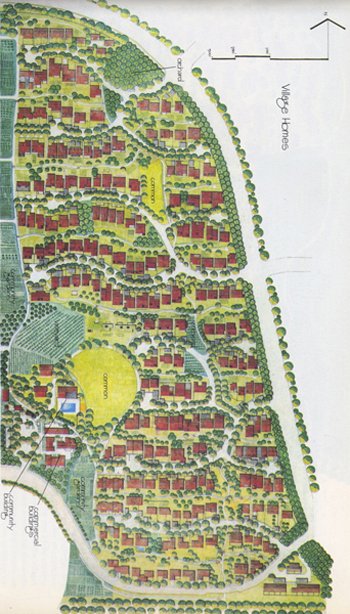
Plan of Village Homes, Davis, CA. Image credit http://web.mit.edu/nature/archive/student_projects/2007/justinf/11.308/index.html
Needless to say, the flames of my imagination were stoked. So when Zach Weiss, Sepp Holzer’s protegee, invited me to explore the place on our fortuitously-timed San Francisco layovers, you bet I jumped in a rental car & high-tailed it to meet him there! The whole drive, I was literally pinching myself wondering if this was a nerdy green dream I’d wake up from!
When Zach & I pulled into the neighborhood, my first impressions were “Wow! This really looks like a normal, albeit lushly landscaped, suburban neighborhood." Not too different-looking from where I grew up, really. (Read: My super vanilla parents would have been totally at ease.) The houses look normal, the streets and sidewalks are all paved, and there’s a definite coherent neighborhood feel to the place.
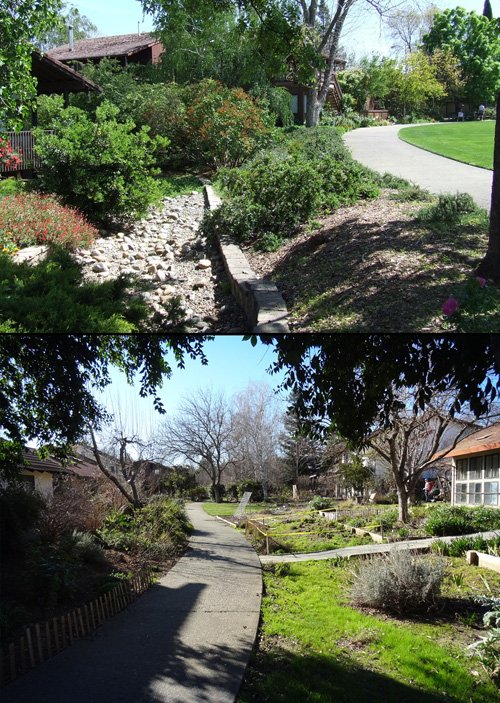
Village Homes, Image credit http://tcpermaculture.com/site/2014/01/06/intentional-permaculture-communities-real-examples/
And then...my other senses started to filter in, and I started noticing food plants - EVERYWHERE. Next to the houses, lining the sidewalks & streets. But so tastefully done & space-appropriate, it felt tidy & intentional (not like the wild & somewhat feral-feeling, semi-overwhelming food forests I’ve been in before, including in my own yard, heh - it's a work in progress, okay?!). Figs galore, pomegranate & pineapple guava hedges, and huge asian persimmons basically bursting off the trees were a few highlights.
(There ARE signs that say the fruit is for residents, but as conscious residents of Earth, we felt this definitely included us.)

Limes & rose bushes adorn the side yard of one of the Village Homes we walked by.
Why incorporate so much food into the landscape? Michael Corbett, project designer, explains:
“The whole idea is by mixing all that food in, you’re producing more locally, you’re cutting down on transportation, and it’s really the way things always were before fossil fuels - you had to be growing as much food as possible.”
After getting out of the car, we were immediately drawn down the sidewalk to a small & sacred-feeling redwood grove for a quick respite. (I love that this is included centrally in the neighborhood as it’s an important part of California’s ecosystem & history.) Zach observed there isn’t much visitor parking, likely by design (In fact, the streets are deliberately narrow to discourage car traffic & keep the asphalt cool & shaded with trees on either side during summer heat). Wandering back onto the sidewalk, we came upon the first of many fruit trees: A jujube tree, Zizyphus jujube, sporting many small, dark red fruits on a very hardy tree that my inexperienced palate can only liken to a milder, differently-textured apple. Zach gathered some in his hands for us to snack on, and we continued along the path.
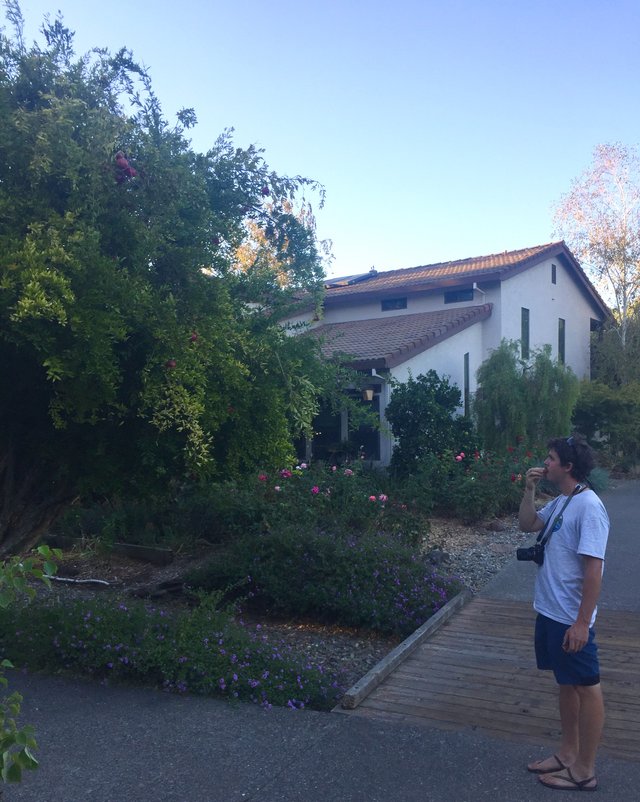
Zach Weiss munching a jujube from the tree.
This paved path, by the way, we can see is no ordinary sidewalk - it’s a regular greenway! A neighborhood-wide loop flanking several “greenbelts” (green spaces for everything from growing food to sports) & wending its way by several thriving orchards. Lined with pomegranate hedges and shadowed by some truly enormous figs that actually made up the overstory in a lot of places, this paved greenway was clearly well loved & maintained, and was being used by adults & children alike during our visit. A few people were peacefully gardening amongst the diversely planted greenbelts, which include citrus trees, amaranth, tons of flowers, & annual garden space. No one seemed to mind us gawking at the lush landscape and snapping photos.
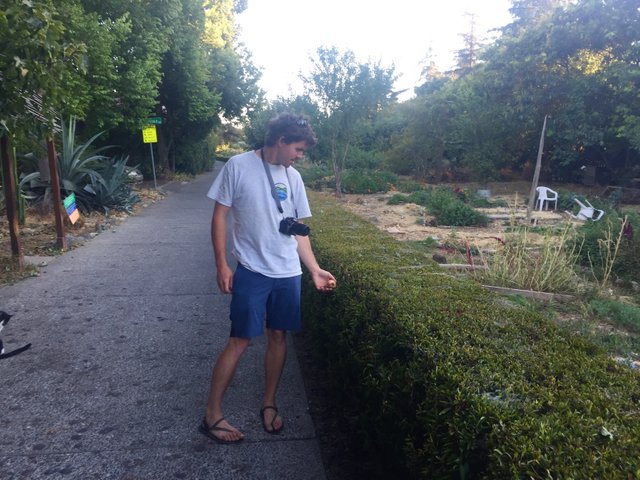
Pomegranate hedges!!!
Upon further research, I discovered that these green spaces between buildings, called greenbelts, are actually deliberately shaped to catch & retain all the rainwater that runs off the roofs in Village Homes. Sinking this rainwater back into the soil, it recharges the groundwater & feeds plants, therefore participating in a complete hydrological cycle.
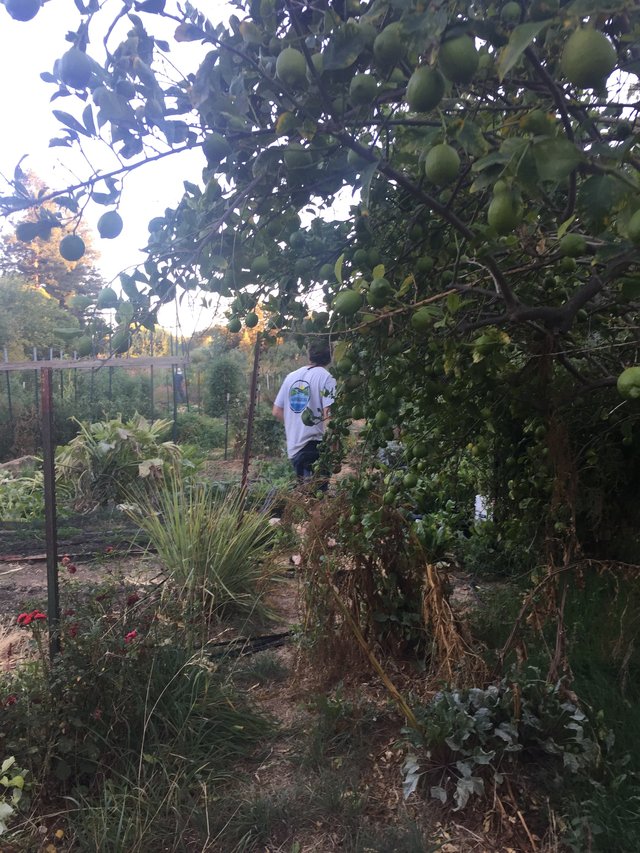
Zach walking through a rain-absorbent green belt, lush with limes & annual gardens.
This differs drastically from most city’s approaches of draining everything off to the nearest waterway, which breaks the cycle of rehydrating the ground & leads to depletion of groundwater, the draining of aquifers, & subsequent drought & fire that we can see now in much of California. Fun fact: This “drain everything off & away” approach is actually a remnant of the times when sewage was disposed of by simply dumping it in the streets, making it necessary to have everything run off completely as quickly as possible to lower the chances of disease from being exposed to, you know, raw sewage. Village Homes’ “natural drainage,” a.k.a. rainwater infiltration system in the greenbelts between buildings is a much more evolved & rational response.
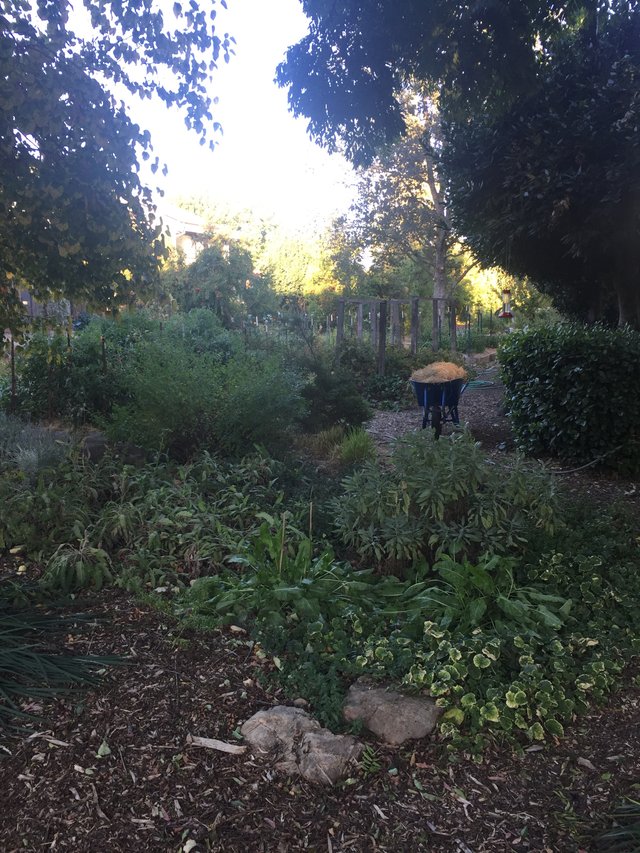
Absorbent green belts grow tons of food and even several thousand dollars of almonds per year!
In fact, the rainwater management setup in Davis has actually been used to take pressure off the flawed existing rainwater systems in the city during times of heavy rain. Michael Corbett, designer, tells the story:
“The city engineers basically said our system wouldn’t work, and made us post an expensive bond to come in and tear it up if it didn’t [take care of the rainwater runoff]. And in the second year, there was a really heavy storm, and the city system was failing, and the streets were getting a foot of water in them - water was actually backflowing into the project & we were taking relief off of the city system!”
Documenting this, Corbett was able to get the bond lifted. Score!
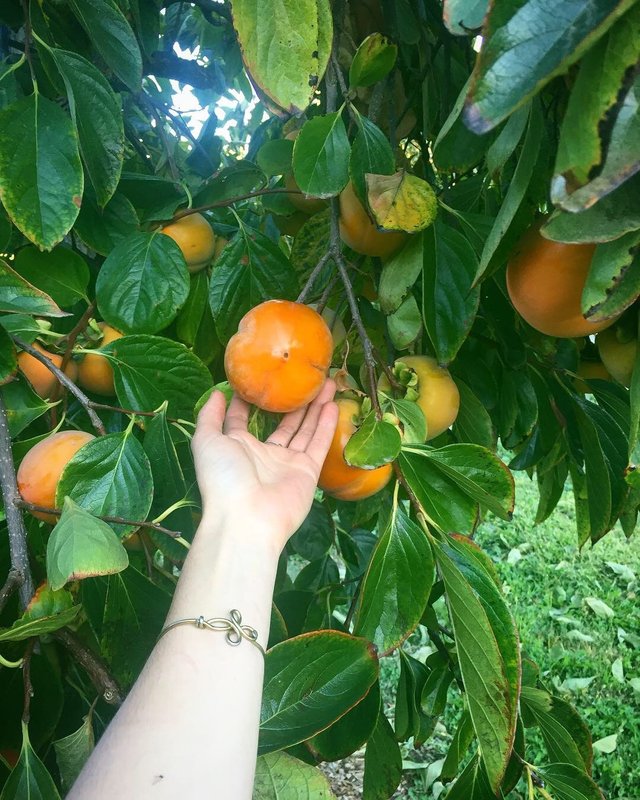
Abundant asian persimmons grown with no irrigation except rainwater runoff.
The scalable, sustainable model found in Village Homes is one that I hope California will look to as the state seeks solutions to the manmade “natural” disasters of drought & fire. I am so beyond grateful for this blissful & eye-opening learning experience I got to share with none other than one of my design idols, Zach Weiss. Thank you Michael Corbett for designing & bringing into being this working model of sustainable living!
xoxo, J
Resources:
- Village Homes: A model solar community proves its worth https://www.context.org/iclib/ic35/browning/
- Geoff Lawton “Food Forest Suburb”:
It is a paradisiacal model
Downvoting a post can decrease pending rewards and make it less visible. Common reasons:
Submit
Absolutely! I can't wait to see more and more of these types of developments pop up everywhere.
Downvoting a post can decrease pending rewards and make it less visible. Common reasons:
Submit
Hello @jennislay, thank you for sharing this creative work! We just stopped by to say that you've been upvoted by the @creativecrypto magazine. The Creative Crypto is all about art on the blockchain and learning from creatives like you. Looking forward to crossing paths again soon. Steem on!
Downvoting a post can decrease pending rewards and make it less visible. Common reasons:
Submit
Yay! Thank you so much! xoxo
Downvoting a post can decrease pending rewards and make it less visible. Common reasons:
Submit
Very nice write up! Thank you for sharing with the interwebs...
Downvoting a post can decrease pending rewards and make it less visible. Common reasons:
Submit
Ben you are the best! I hope to run into you soon! <3
Downvoting a post can decrease pending rewards and make it less visible. Common reasons:
Submit